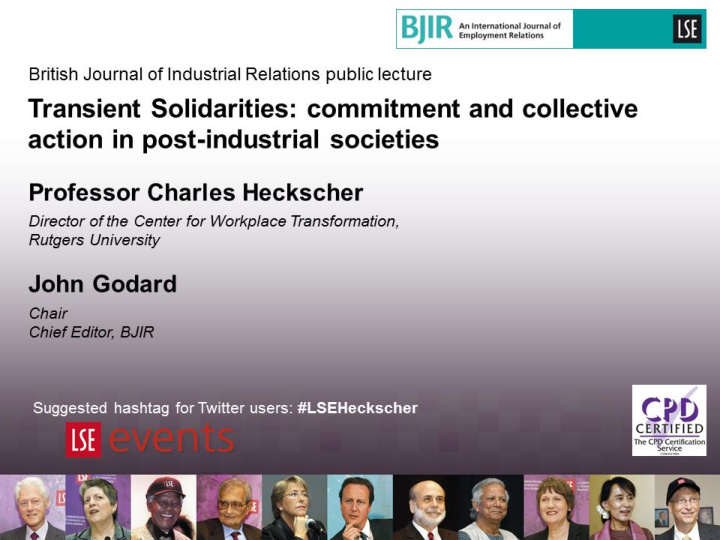



Transient Solidarities Charles Heckscher January, 2014
Shared sense of obligation Solidarity to participate in collective action for social change RAWA Solidarity Scotland - rawascotland.org.uk
Strikes 4
Theory Solidarity = Relations + Ideology (moral appeal)
Types of solidarity Organization / Relations Ideology collective action Craft Industrial
Craft solidarity Relations Strong self-governing occupational communities Internally established status hierarchies Ideology Universalization of way of life (artisanal, independent, communal, local self governance) Collective action / organization Participative, continuous Status-dominated organization Small scale Multiple tactics, flexible Not essentially conflictual
Industrial solidarity 9 http://www.huffingtonpost.com/2012/09/14/chicago-teachers-strike-n_0_n_1883626.html
Industrial solidarity Relations Similar jobs in large groups (factories) Constant friction with management Ideology Extension of equal rights Balance of power Dualism / battle Collective action / organization Centralized organization, large scale Focused demands Mass actions
Industrial solidarity: organization
Types of solidarity Relations Ideology Collective action Craft Traditional, self- Way of life; Continuous, governing utopian decentralized communities decentralized community Industrial The factory: Extension of Centralized mass, rights episodic, oppositional Confrontation oppositional, simple focus Attractive New Types of ?? ideological relations? action? appeals?
What’s happening with relations?
Transient relations At work Decentralization Instability / fluidity In society Personal entertainment Self-enhancement Weakened loyalties 14
Small world 1 5
But … 1.3 billion 1 6
17
Transient relations: “Friending” Developing since (at least) 1960s Deliberate (conditional) Complex Diverse, multiple intersections Wide scope Many levels of intensity Seeking understanding
Small world Cohesive small world 1 9
Who are these “ frienders ”? 1/3 – 1/2 of (US) population 44% say they join diverse groups to learn about themselves 40% say they are active in web discussions Not heavily young or educated Embrace classic ethic of hard work and individual responsibility 20
Social media users (research) Equally or more engaged in community and politics Maintain “real world” friendships and relations Act on political messages, transmit them to wider circles Have diverse extended circles Not limited to those with high social confidence 21
Cohesive small world Solidarity? 22
Ideology (vision of desirable society) Diversity Openness Sharing Mutualism Learning Contribution 23
Collaborative solidarity: the Mozilla mission We’re building a better Internet Our mission is to promote openness, innovation & opportunity on the Web. At Mozilla, we’re a global community of technologists, thinkers and builders working together to keep the Internet alive and accessible, so people worldwide can be informed contributors and creators of the Web. We believe this act of human collaboration across an open platform is essential to individual growth and our collective future.
I
Collaborative solidarity: MozFest “more hack less yack” “more hammer less yammer”
Holland Philppines Malaysia London 2 7
Organizing a cohesive small world orchestrator 2 8
Orchestrating the new relations Purpose Image of a desirable 1. shared future Platform 2. Tools Data Connections Process 3. Celebrating successes Enforcing norms Focusing campaigns
Focused (conflictual) action: Swarming (not a mass) “systems in which autonomy, emergence and distributedness replace control, preprogramming and centralization”
Swarming: examples Disabilities movement (US) Zapatistas Anti-SOPA mobilization Wal-Mart campaign? Banking campaign? 31
Relations Ideology Collective action Craft Traditional, self- Way of life; Sustained self- governing utopian protective communities decentralized organization community Millennialism Industrial The factory: Extension of Episodic, mass, rights oppositional oppositional Manichean uprisings, opposition simple focus Collaborative Networked Openness, Orchestrated “friending” diversity, “projects”, (Cohesive small understanding swarms world) 3 2
Collaborative solidarity Multiplex Coordinated projects Reflexive (connection to purpose) Not essentially conflictual 33
Workers of the world: hack! network! swarm! 34
Recommend
More recommend